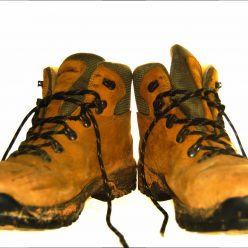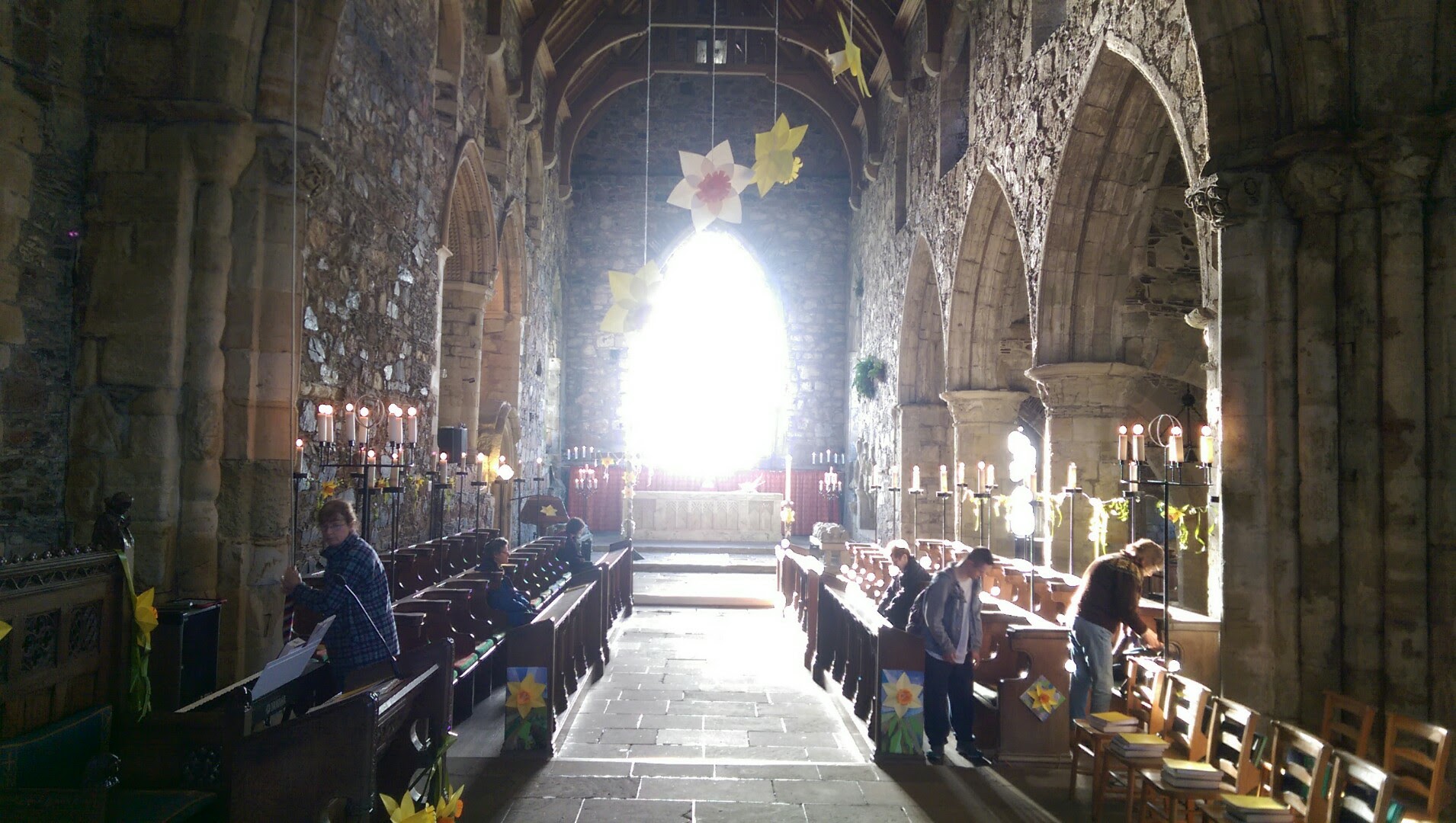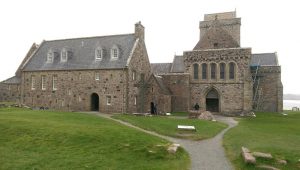 I spent Easter as a guest at Iona Abbey. The communal side of the Abbey is run by the Iona Community, while the Tourist side is run by Historic Scotland. Most importantly the worship that regularly happens in the Abbey is largely under the auspices of the Iona Community. Therefore if you go to the communion service on Easter Day at Iona Abbey you are attending a communion service that is run in line with the principles of the Iona Community. The Iona Community has two areas of concern that play significant roles in what goes on during Easter week. These are:
I spent Easter as a guest at Iona Abbey. The communal side of the Abbey is run by the Iona Community, while the Tourist side is run by Historic Scotland. Most importantly the worship that regularly happens in the Abbey is largely under the auspices of the Iona Community. Therefore if you go to the communion service on Easter Day at Iona Abbey you are attending a communion service that is run in line with the principles of the Iona Community. The Iona Community has two areas of concern that play significant roles in what goes on during Easter week. These are:
- the building of the common life between the guests, volunteers (vollies) and resident staff.
- the renewal of worship as the activity of the people
Therefore guests had part in the preparation of worship as well as sharing household tasks and serving at meals.
I have separated that into three the people who live and work around the Abbey under the auspices of the Iona Community. Those are the boundaries as used by the community but the boundaries are not as clearly drawn as such. The guests do work, that includes serving and washing up after meals, household tasks including cleaning toilets and participating in the preparation of worship. The tasks are less arduous than those undertaken by the vollies and Residents but still necessary for the well functioning of the Abbey. They are not purely symbolic. Technically most resident staff are also volunteers but long term with contracts (between nine months and three years). There is a subtle and complex interplay between these three groups.
The worship team, i.e. the resident staff who have a contractual responsibility at present for worship are Rosie (Director), Deborah (Sacristan), Richard (Musician) and Callum (Musician).
I was a guest. There were around 37 guests present this week and in three chore teams. Most of the rooms were shared with twin or bunk beds. The rooms are cosy space wise and this is good because it also helps with their cosiness in other ways as the building has limited heating.
From our perspective, the preparations for the Triduum started on Monday when people start preparing for the stations of the cross on Good Friday. The Iona Community takes overall organising responsibility with Bishops House Retreat Centre for the one at the Heritage Centre and the Parish Church doing the one at the Parish Church. The Iona Community then asks the guests for the week to prepare the other five.
The second part of preparation that was handed over to us was the sermon slot for the communion on Easter day. This, however, only started on Wednesday. Actually, you could say we divided ourselves into seven teams. The five for stations of the cross, one storying team and a movement team who eventually ended up being involved in the Easter Sunday Evening Service.
The third part, and it is only third because I keep forgetting it was done, was the Big Sing and the not so Wee Sing. These are times when guests are taught the music for upcoming services. This is not a choir rehearsal but a chance to familiarise us with the music and teach parts. If you have ever been to Iona Abbey services and participated in the congregation singing happily in three parts, then this is how they do it. Basically, a significant proportion of the congregation has already been primed. I was spoilt as the number of musicians among the guests was large and therefore we did four part rather than the usual three part harmonies.
The first service was the foot washing which happened on the Tuesday in the Chapter House. That might seem odd being outside the Triduum but Tuesday is the day the Iona Community runs pilgrimages around the Island. There are two an on-road and an off-road. Therefore there are lots of tired sweaty feet in the afternoon. In other words, the timing was chosen so it was at the point when feet needed washing. Oddly we were a fast group and three of us had already gone through the process of cleaning our boots! It was low key. Rosie explained what was going on. The song “Brother, sister Let me serve you” with resident staff and vollies making sure that water and towels were available. The process of washing feet was mutual. Anyone could sit in a chair for their feet to be washed; equally, anyone could take the place of the foot washer on the floor.
However, like all modern Protestant liturgical Triduums it really kicked off properly on Thursday Evening with a Gathering in the upper room. This is probably Protestants nearest equivalent to Corpus Christi. This was held in the refectory

This focussed both on the foot washing from John’s Gospel but also the institution of the Lord’s Supper. There has been a large use of John this Lent, not quite sure whether that is because Matthew is difficult or just people wanting John for a change. The room was packed with the tables put up against the walls, the benches and upright chairs in front of them. The poem “Directions for using a towel” was read, the hymn “Great God your love has called us here“. That hymn is one of my favourites simply because it catches the complexity of the human condition in ways that speak to the sociologist in me. There were four stations at which communion was served: one for Judas, one for Peter, one for Thomas and one for another disciple with us being asked to go to the one that reflects where we are at.
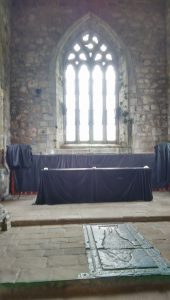
The service closed with us leaving singing Jesu Tawa Pano and processing to the Abbey. The Abbey was then stripped. That is any ornament that could be taken out of the Abbey was removed including the Celtic Cross that is normally on the high altar. Anything that could not be removed was draped in black and all the candles were put out. The photo shown was taken I think the following afternoon but it gives an idea of the starkness of the stripped church. This was all done in total silence and the residents and volunteers doing the stripping were all dressed in black. We left our way lit by battery lanterns and we all went out by the main door rather than to the cloister.
Friday was the busiest day worship-wise. It started with the normal morning office in the stripped Abbey. Then it was on with tasks but pretty soon had to set out for the stations of the cross. As far as I can recall the progress was as follows:
- Martyrs Bay – Jesus Condemned
- War Memorial – Jesus is mocked
- Nunnery – Women Comfort Jesus
- Heritage Centre – Jesus Falls
- Parish Church – Jesus is Crucified
- St Martin’s Cross – Jesus Dies
- St Columba’s Shrine – Jesus is buried
Now I am going to have to give an impression. The day was dreich and full waterproofs were a good idea. On the other hand, it certainly attracted people and by the time we got to jetty there was a crowd following the cross including Iona Community members who were not part of the staff at the Abbey. In between each station, we moved singing a short chant quite often from Taize. I am afraid it did not really get going for me until the women at the Nunnery where we heard the interaction between Mary, Jesus’ mother and modern women’s stories. The Bishop’s house connected Jesus’s fall with all the whys we have. The cross was dropped and instead of a man picking it up a woman did. The Parish church was a meditation by Barabbus asking us whether if we could get out of suffering we would not let someone else take it for us. The crucifixion was two monologues by two soldiers taking different aspects. One took the Dorothy L Sayers idea that one might have been the centurion whose servant had been healed by Jesus. The final one involved taking the body of Jesus and laying it in St Columba’s Shrine. Then the door of the shrine was slammed shut.
From 2:00 to 3:30 pm there was a vigil kept in the church. I along with many others by this time was flagging. I dropped off a couple of times during the vigil but stayed. However, quite a few others left early precisely because they were falling asleep. The result was the Abbey which was about half full at the start of the vigil was only a scattered few mainly in the choir seats and we drifted out after the end.
That evening it was a dispersed service. This was services in small spaces around the abbey. For instance, there was one gathering in St Columba’s Shrine, one in the Abbey Library and the one I attended in the Burrows. I went to the Burrows for two reasons. Firstly it was warm and worshipping in the warmth appealed to me. Secondly, it is a utility space used for washing and drying clothing and sheets and as a short cut to the kitchen. It really was the core space for me while I was a vollie on the Abbey Housekeeping team over a decade ago. The service was short and focused on a reading of Lamentations 3. In the Burrows, there were 6-10 people present and we were full.
Easter Eve started once again with the morning office in the stripped Abbey. This was very routine. The differences from normal were slight in that there was no music playing when we came in and we sang unaccompanied. On the evening was a service of waiting. This gave time to reflect on the actual importance of paying attention to waiting. Again a very stripped down service and quite meditative. This was kept as a partial fast day as I think was Friday and no puddings were served but only fruit. Oddly enough outside of worship, an excitement was beginning to boil as the last preparations were being done for the Easter day service.
Easter day started with a 6:15 at St Oran’s Chapel. This is the chapel in the burial ground beside the Abbey. The day had a damp start and once again I could have done with waterproofs trousers as well as coat and walking boots. The acclamation was joyful and we were handed a flower (not necessarily a daffodil). There were candles representing Easter fire but in the damp, they were rather poor. A good volume of Halle, Halle, Halle as we walked from St Oran’s to the Abbey where we left our flowers at the font before progressing through the cloisters for the Wee Breakfast still singing. The Wee Breakfast consisted of Simnel Cake and Hot Chocolate (alright I was a party pooper and chose hot cross buns and tea but that was just me).
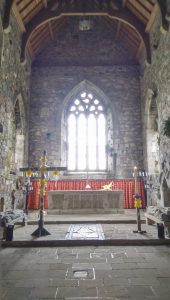
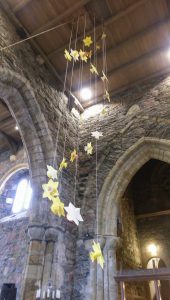 Sometime between the waiting service and 9:00 am on Easter Sunday the Abbey had been re-decorated with daffodils everywhere. The cross with the daffodils on it was actually carried down at the start of the service and the high altar had a white communion cloth on it.
Sometime between the waiting service and 9:00 am on Easter Sunday the Abbey had been re-decorated with daffodils everywhere. The cross with the daffodils on it was actually carried down at the start of the service and the high altar had a white communion cloth on it.
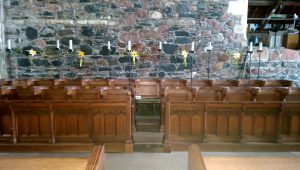 The candles were lit unlike in the photos which were taken on Sunday afternoon. I had a reserved seat for the service because I had been part of the storying group and needed to be able to get to the microphone at the main desk.
The candles were lit unlike in the photos which were taken on Sunday afternoon. I had a reserved seat for the service because I had been part of the storying group and needed to be able to get to the microphone at the main desk.
The attendance was such that people were standing outside the Abbey and therefore the doors could not be shut. Handbells were used twice during the service and we also had a group of guests doing shape-note singing. The hymns tends to be modern versions of Easter classics so we had “God given Glory” instead of “Thine be the Glory” and a new version of “Jesus Christ is risen today” both by Jan Sutch Pickard. Equally the form was actually very strongly based on the form given in the Iona Abbey Worship Book with seasonal words used. The text for the service was John 20:1-18, this got represented three times. Firstly it was read, secondly the modern form of “Jesus Christ is risen today” tells it again and finally, the storying group had interwoven this story with the stories of others told during the week and finished with an invitation to create a new story.
You would think with all that, that Easter was over but this was the final day on Iona for us guests and we would be leaving on 8:50 ferry next morning. Thus, as is customary the night before guests leave, there was a service of commitment. It was a quiet abbey in the evening where a good number of people gathered for the service. I know because I was sat in the choir stalls when we were asked to come forward for the act of commitment and for a considerable time after I returned to my seat people filed in. The movement which was based on actions symbolising community was done in silence in the space before the act of commitment. It felt the most personal service. This was odd. Commitment services usually have high guest inputs but because we had been so busy during the week we did very little apart from the movement and yet it still drew us in.
